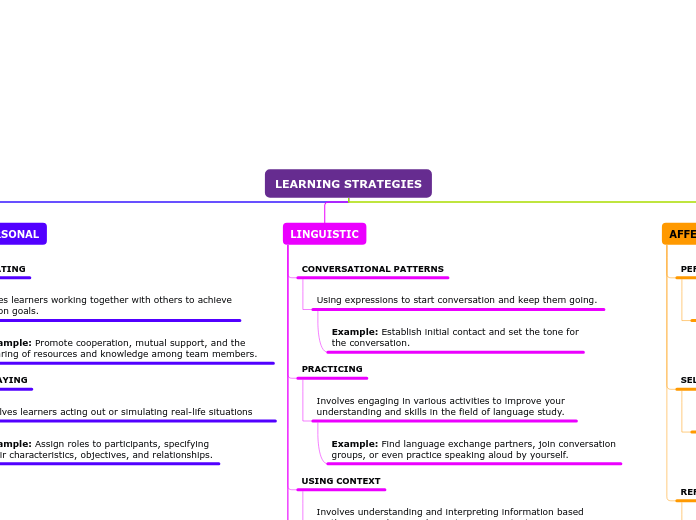LEARNING STRATEGIES
COGNITIVE
CLASSIFYING
Refers to the process of grouping or categorizing information based on similarities or shared characteristics.
Example: Classify the different animal species.
PREDICTING
Predicting involves making educated guesses about what will happen next based on available information and prior knowledge.
Example: students may be studying a unit on plants and must predict what will happen to a plants growth if the amount of water is increased.
INDUCING
Looking for patterns and regularities.
Example: In mathematics, you can induce patterns by examining number sequences or geometric shapes.
TAKING NOTES
Helps to actively engage with the material and promotes better understanding and retention of information.
Example: Use headings, bullets, numbering, and indentation to organize notes in a structured way.
CONCEPT MAPPING
Involves visually organizing and connecting ideas and concepts to enhance understanding and retention.
Example: Collect all the relevant information, ideas, and concepts related to the main topic.
INFERENCING
The process of drawing logical conclusions or making educated guesses based on available information and prior knowledge.
Example: Engage in critical thinking and use deductive and inductive reasoning to draw conclusions.
DISCRIMINATING
It refers to the mental process of identifying and understanding the distinct characteristics or features of objects, ideas, or events.
Example: Develop a habit of observing and noticing small details in the information or tasks you encounter.
DIAGRAMMING
Involves creating visual representations of information or concepts.
Example: Visual representation, concept mapping.
INTERPERSONAL
COOPERATING
Involves learners working together with others to achieve common goals.
Example: Promote cooperation, mutual support, and the sharing of resources and knowledge among team members.
ROLE-PLAYING
It involves learners acting out or simulating real-life situations
Example: Assign roles to participants, specifying their characteristics, objectives, and relationships.
LINGUISTIC
CONVERSATIONAL PATTERNS
Using expressions to start conversation and keep them going.
Example: Establish initial contact and set the tone for the conversation.
PRACTICING
Involves engaging in various activities to improve your understanding and skills in the field of language study.
Example: Find language exchange partners, join conversation groups, or even practice speaking aloud by yourself.
USING CONTEXT
Involves understanding and interpreting information based on the surrounding words, sentences, or situations.
Example: When reading books, articles, or any written material, pay attention to the context of the words.
SUMMARIZING
Involves condensing information into concise and coherent summaries.
Example: Focus on capturing the essential ideas and concepts while eliminating unnecessary details.
SELECTIVE LISTENING
Focusing on specific information or key points while filtering out irrelevant or less important details.
Example: While listening, try to grasp the main idea or central theme of the conversation.
SKIMMING
Involves quickly glancing over a text to get a general idea of its content.
Example: Skim through the paragraphs, focusing on the first and last sentences.
AFFECTIVE
PERSONALIZING
Learners personalize their learning and connect the new information or skills to their own experiences, interest, and goals.
Example: Engage in discussions, study groups, or online communities where you can share your thoughts and ideas related to the subject matter.
SELF-EVALUATING
It involves learners reflecting on their learning process, assessing their strengths and weaknesses, and making adjustments to improve their learning outcomes.
Example: Identify your strengths and weaknesses in relation to the learning task.
REFLECTING
It involves learners actively thinking about and processing information, experiences, and emotions to enhance learning and personal growth.
Example: Ask yourself meaningful questions that encourage introspection and critical thinking.
CREATIVE
BRAINSTORMING
Encourages generating ideas and solutions in a group or individual setting.
Example: Encourage participants to generate as many ideas as possible without evaluating or criticizing them at this stage.
